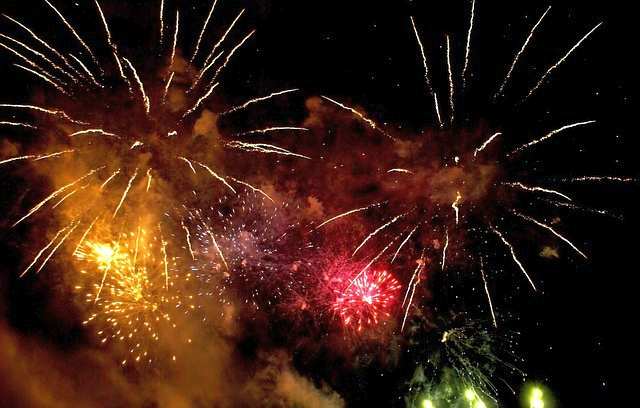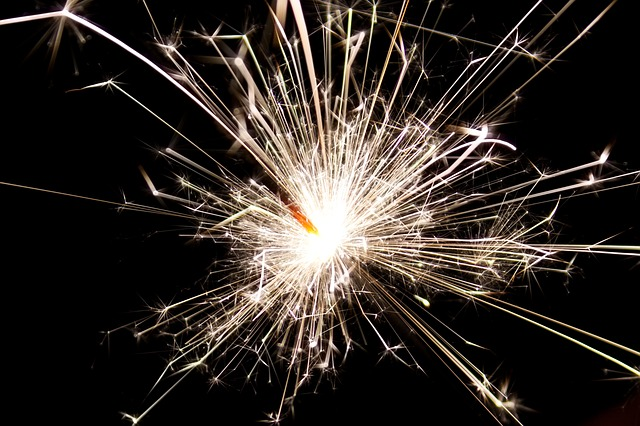 Pyrotechnics, often called fireworks, has a long history dating back to the days of gunpowder (black powder), developed in 9th-century China.
Pyrotechnics, often called fireworks, has a long history dating back to the days of gunpowder (black powder), developed in 9th-century China.
Whether it is a sizzle, an explosion, or a showy display of colorful lights and sounds, the chemical reactions involve oxidation/reduction (REDOX) chemistry.
What Is Oxidation?
Oxidation is essentially the removal of electrons. Consider a very simple example.
An uncharged sodium atom (symbol: Na) has 11 negatively-charged electrons. The atom has no net charge, however, because in its center part or nucleus, there are 11 positively-charged protons.
Sodium can lose one electron to form a positively-charged ion called a cation. Now we can look at this process as if it were a mathematical equation. If we have the number 4 and we wind up with the numbers 3 and 1, we can write this either as 4 = 3 + 1 or 4 – 1 = 3. For our sodium atom, we can write either
Na → Na⁺ + e⁻
or
Na – e → Na⁺
Chemists call the above a half-reaction, since it is only the oxidation half of an oxidation-reduction reaction.
What is Reduction?
If oxidation involves the removal of electrons, reduction, being the exact opposite, involves the gaining of electrons. Returning to our example, when sodium is exposed to the oxygen in the air, it is quickly forms the oxide. Since oxygen has an affinity to gain two electrons (it has a valence of minus two), we write,
2 Na + O2 → Na2O
Notice we have removed charge signs to simplify.
It is no coincidence we use the word oxidation, since oxygen is historically the best-known oxidizing agent. Oxygen is more than happy to “steal” electrons from many other substances.
In this instance, if we ignore the neutrality symbol for elemental oxygen, the reduction half-reaction is written,
O2 + 4 e⁻ → 2 O-2
Or, of course, we could have written it in its alternative or subtraction form.
What About Those Electrons?
In the sodium and oxygen example, we could have written the reaction by combining the half-reactions. But the electrons term cancels out. Multiplying the sodium equation times two and the oxygen equation by a half and then combining the two, we see that,
2 Na – 2 e + 1/2 O2 + 2 e⁻ → Na2O
Gunpowder (Black Powder)
So what is the chemical reaction behind the fizzling and exploding of gunpowder? It is more complex, but follows the reasoning given in our simple example of sodium and oxygen…
10 KNO3 + 3 S + 8 C → 2 K2CO3 + 3 K2SO4 + 6 CO2↑ + 5 N2↑ (+ Heat)
In the above reaction, nitrate is reduced, carbon and sulfur are oxidized. It is the gases and heat that give the desired effect.
The sudden production of a large quantity of gas causes has to escape. The gunpowder fizzles if its confinement is not too tight. If the encasement is stronger, unless overpoweringly so, the gunpowder explodes with a large Bang!
Moving On to Color
Pyrotechnics at fireworks shows display a range of colors, especially red and green.
The red color comes from strontium nitrate, Sr(NO3)2., as can be seen in this 17-second video…
Green is produced by barium nitrate, Ba(NO3)2. This short video of a flare demonstrates how barium imparts a green color…
Although both strontium and barium nitrates are (in themselves) oxidizers, other chemicals, including the much stronger oxidizer potassium chlorate, plus reducing agents (such as sugar), are added. For instance,
8 KClO3 + C12H22O11 → 8 KCl + 12 CO2↑ + 11 H2O↑
Interestingly, an intense blue color results from the use of copper compounds in pyrotechnics. Yellows and oranges and even purples can be imparted to fireworks through the use of certain metal carbonates – calcium, sodium, and rubidium, respectively.
Let’s Not Forget Sparklers!
Sparklers possess a considerably different chemistry from gunpowder and from color pyrotechnics. In fact, the primary ingredients can be as simple as aluminum (or other reactive metal, such as magnesium) powder and sulfur. Both of these substances are elements, containing no oxygen. We can write, for example…
4 Al + 3 S2 → 2 Al2S3
So can we say there is an oxidation-reduction reaction involved? Yes, we can. How so? Sulfur is the oxidizing agent! Sulfur is closely related, property-wise, to oxygen, but is a solid, not a gas. Some varieties of combustion thrive in the presence of sulfur. Perhaps you’ve heard of the Biblical punishment of Sodom and Gomorrah, how they were pelted with fire and brimstone? Brimstone is simply another word for sulfur.
And Away We Fly…
Let’s close with a short (46 second) video of some pyrotechnics rockets…
Note: You might also enjoy Carbide Cannons & Miners’ Lamps – The Chemistry?
References:
- Project Muse: Gunpowder, Explosives, and the State: A Technological History
- University of Wyoming: Fireworks
- Quirkyscience: What Causes Chemical Explosions?

Very interesting and colorful explanation of fireworks.